These irreplaceable registration cards
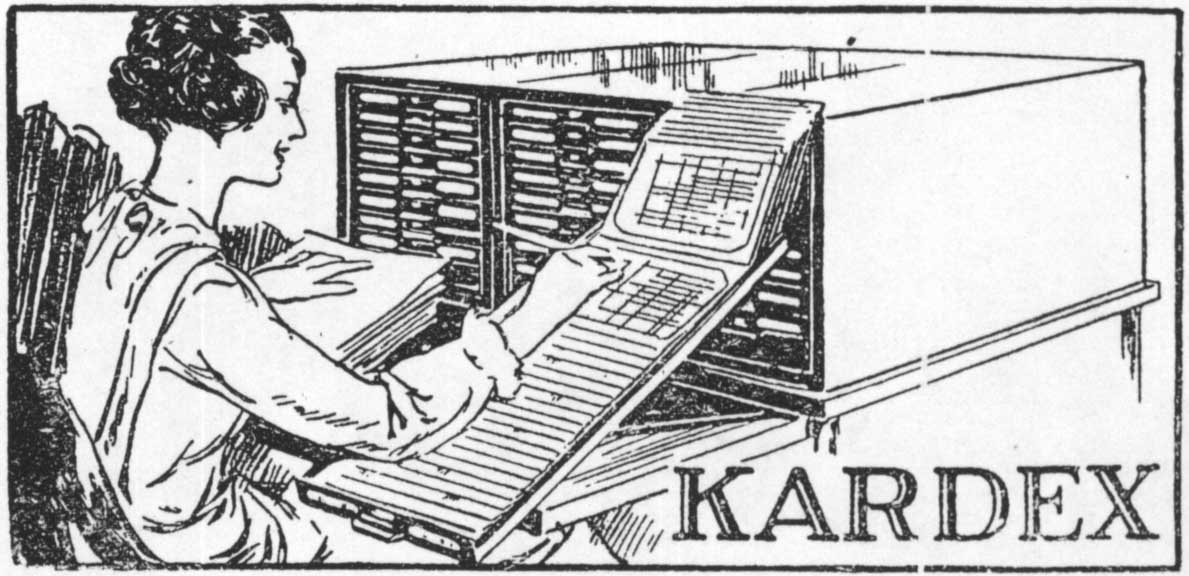
The cycle of posts devoted to the old office equipment continues.
In past posts I talked about Russian accounts and devices for copying , in this post I offer to the attention of habravchan an illustrated overview of registration cards.
Post long because of the many pictures.
The background to the invention of the cards nowhere seems to be written down, but rather understandable.
After the invention of writing, people learned to record business information "for memory". At first the information was recorded in the form of an arbitrary text.
Take a look at these historical documents:

')
These are not letters at all, but pages from Russian account books from 1647 and 1649. They are not very similar to modern ones due to the lack of structure, as it is easy to guess.
At least the last couple of centuries, accounting books and statements are compiled in tabular form, which is much clearer than randomly written text.
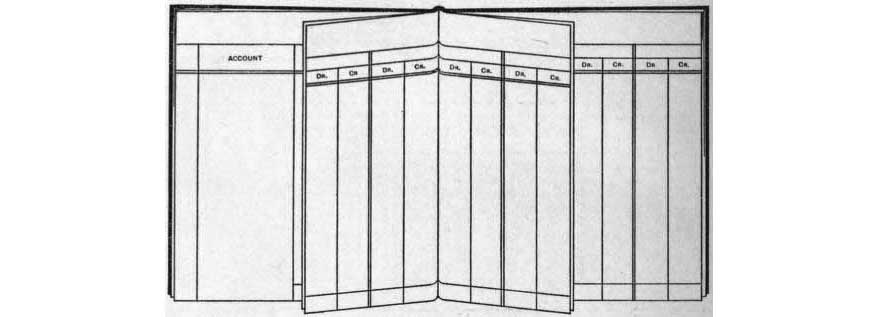
In the development of this idea, obviously, cards were invented.
Writing business information to the tables is extremely convenient compared to the previous method, but the tables are also not without drawbacks. In particular, the information recorded in them cannot be sorted or selected. Well, how do you sort or select the data recorded in portions in the rows of the registration table? We have to draw up a new sheet in which to rewrite the necessary information again. Tires, of course ... unless you write down meaningful information blocks on separate sheets - cards. Cards are not stapled together, as a result, they can be stacked and shuffled as you like.
Proceeding from such considerations, as far as can be supposed, cards and card files were invented.
In the accounting literature, the invention of the card indexes (mid XIX century) is attributed to the French abbot J. Rozier , and their first use in the accounting of his compatriot I.S. Kine , but I will not take to judge how this is true. In the end, primary documents can also be interpreted as registration cards - put them in a bundle, each mind will get - and they began to be compiled in ancient times. Recall at least the Sumerians with their clay accounting plates (however, how the Sumerians kept accounts, God only knows).
In any case, the cards were not invented in Russia. We talked about card files only with con. XIX - beg. Twentieth centuries.
The chronology I know looks like this:
- in the book N.I. Shishkov, “Accounting for the illiterate,” published in 1890 in Vyatka, card files are by no means mentioned;
- in 1902, in St. Petersburg, the firm “Main warehouse of Swedish-American office furniture” was created , which was involved (probably, among other things) in organizing and managing office work on the card system;
- On December 14, 1909 in St. Petersburg, at the meeting of the academic department of the Russian Accounting Society for Mutual Assistance, the report “The Card System in Bookkeeping” was read. Speaker - Sergey Vasilyevich Mylnikov , accounting teacher in the courses of M.V. Pobedinsky.
A year later, Mylnikov managed to publish the report in the form of a pamphlet, so this person, apparently, should be considered the initiator (or rather, the first popularizer) of card accounting in Russia.

Although at first they did not pay attention to card bookkeeping: at that time other ideas and other people were in favor. It took an end to tsarism, so that young and not very educated, Soviet accountants, who had seized upon public posts, discovered a wonderful foreign invention and began to advertise it wholeheartedly.
It was then, in the mid-twenties, S.V. Mylnikov managed to publish a second book on card bookkeeping, but such books began to go out one by one, even translations of foreign brochures appeared, and the pioneer again did not get the piece of fame he deserved. However, Sergey Vasilyevich Mylnikov did not mention anything original: the report, read back in 1909, remained his finest hour.
And what file cabinets? Oh, they flourished all the 1920s and 30s. and subsequently did not lose their meaning, because the idea: to write data on one-dimensional cards, which are put in a pack, was a miracle as good.


Bundles of cards - was it necessary to store them somewhere? - It was supposed to be put in special boxes.

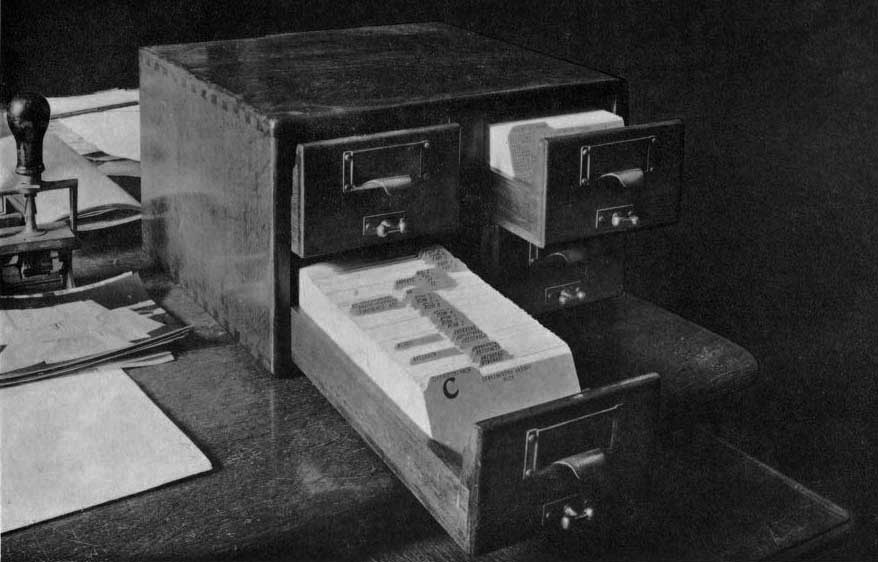
In turn, the boxes were placed in cabinets, as a result of which they turned out ... I almost wrote, everyone knew - yes, no, of course, everyone knows, although young people rarely visit libraries today - a card index.

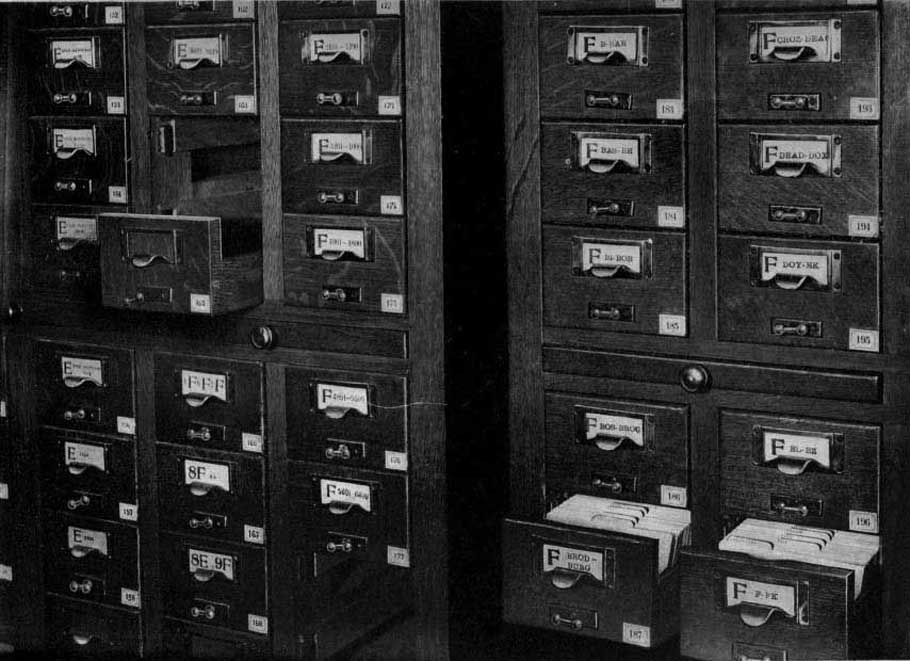
Card files were used in libraries, bookkeeping and office - wherever it was necessary to work with large databases. Work with the card indexes was actually arranged: you find a box, and inside you need a card, and the card can be removed at any time to be replaced with another one, and you can also insert a new one between two existing cards.
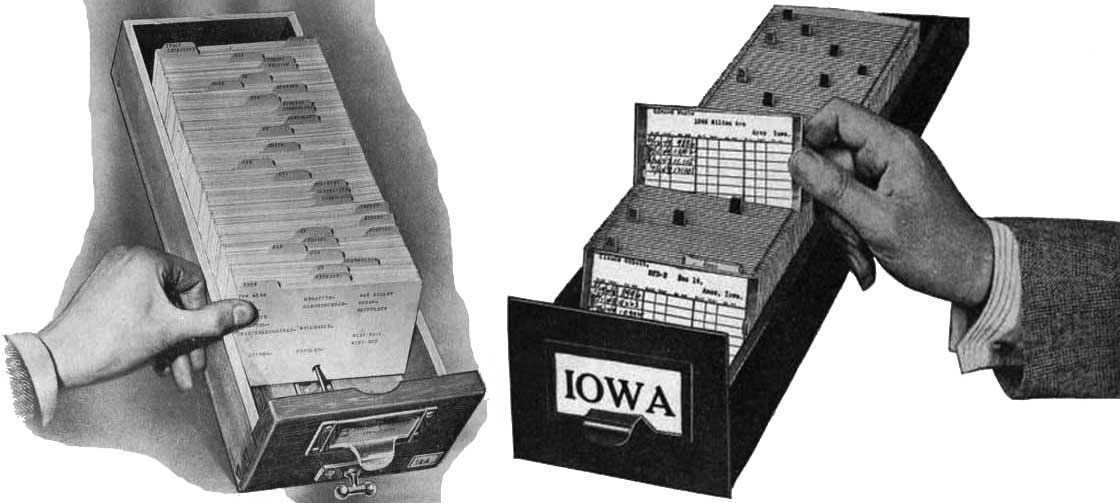

In order to quickly find the necessary cards in the box, it is desirable to shift them with separators-indices (meme-indices). As a rule, meme indexes were performed in the form of cards with special projections.
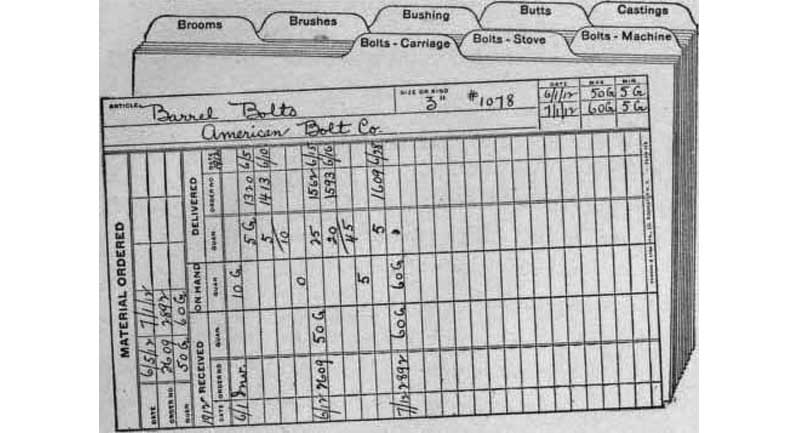
In some cases, on the contrary, an incision was made in the cards (then the meme indices were called tabs - however, not always: young authors used terminology rather freely).

For better navigation, use clips called riders . The riders differed from the index cards in that they could be removed from one card at any time and fixed to another.
A sample card file in which indexes are combined with riders:

Office equipment is as individual as clothing: as now everyone chooses a computer to his own taste and color, so in the 1920s and 30s. librarians, accountants and clerks chose riders to suit their individuality. Some chose, others did business on it, throwing into the market more and more new models.


And people bought because it is convenient! I adore stationery and buyers perfectly well.
And the authors of numerous textbooks explained to uninformed customers how to use riders correctly.


Sometimes separators were installed not in the cards, but in the boxes themselves.
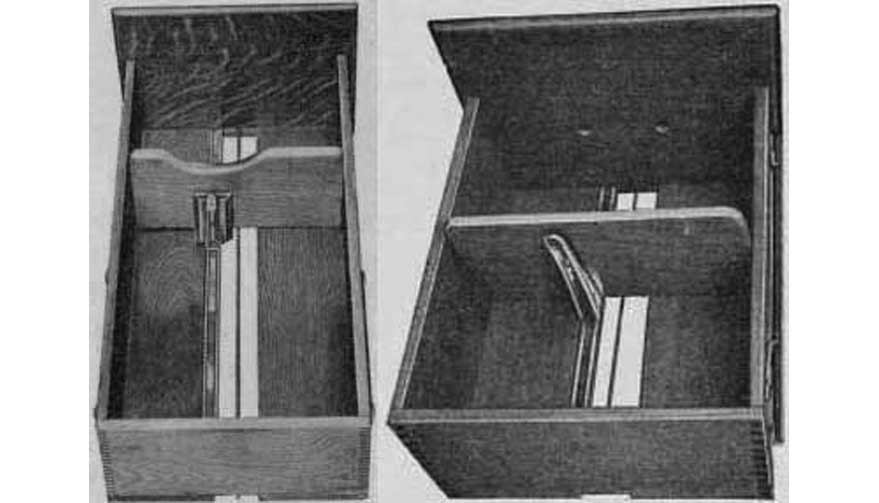
It is impossible, we must not forget about the boxes, which are the most important part of the file! Much depends on the shape of the filing cabinet, so they were produced in the most unimaginable forms and models. Demand dictated the offer.

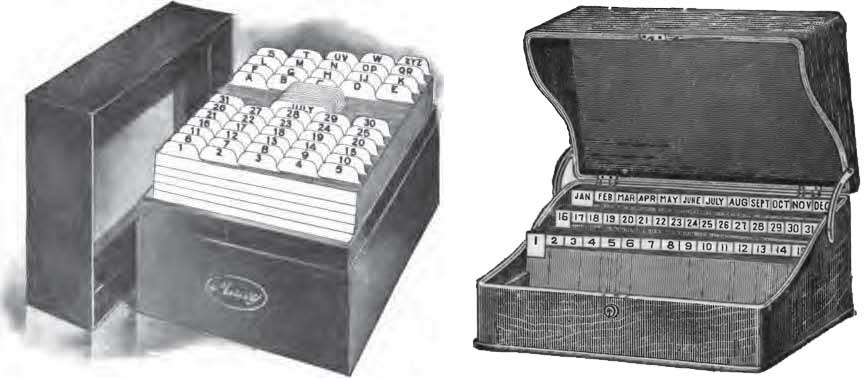
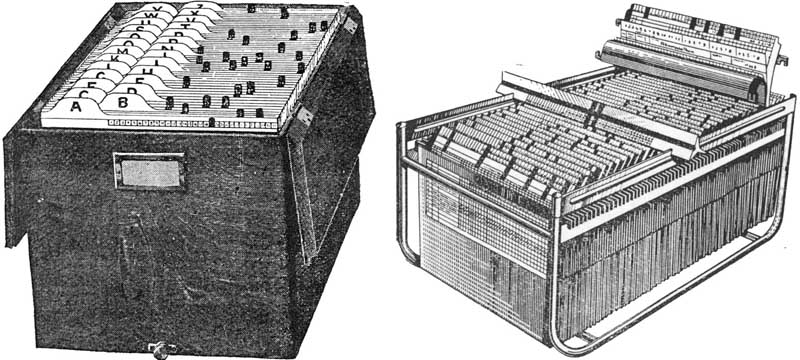


In addition to individual boxes, for keeping the filing cabinets, I guessed to adapt desks or desks:
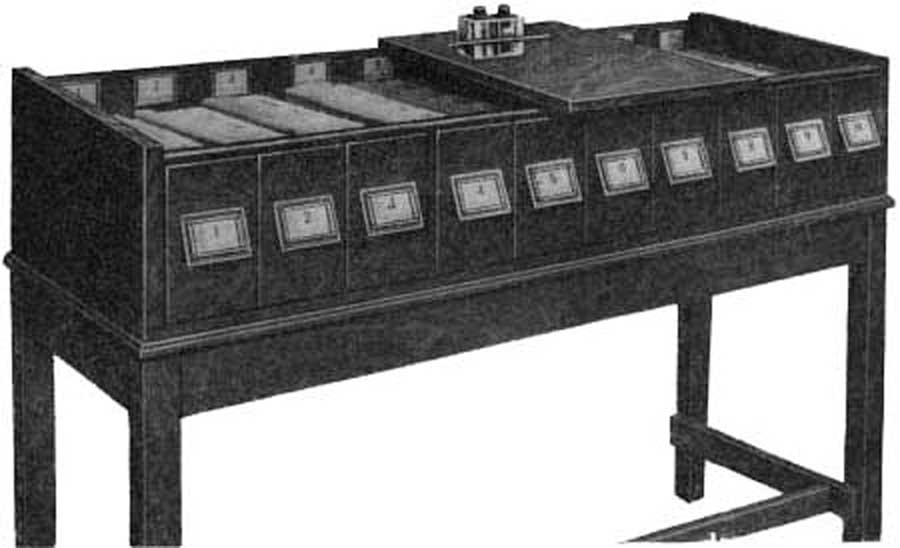
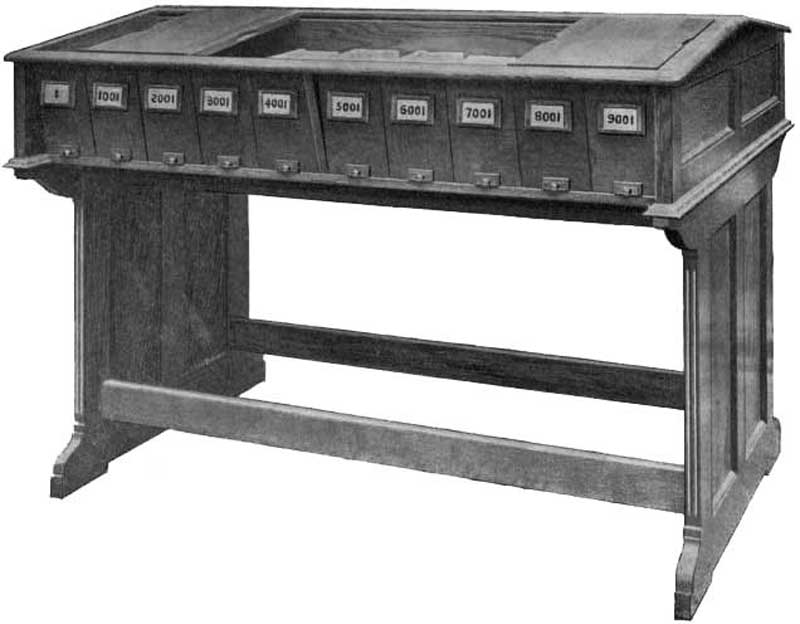
The classic way to expand your filing cabinets is cabinets, of course! Drawers with drawers, but if there are a lot of individual drawers or desks, you just need to create a cabinet, that is, to produce special cabinets for office card files. The most important part of office furniture: I think, the company “Main warehouse of Swedish-American office furniture”, which supplied the card files to St. Petersburg firms, did not lose.

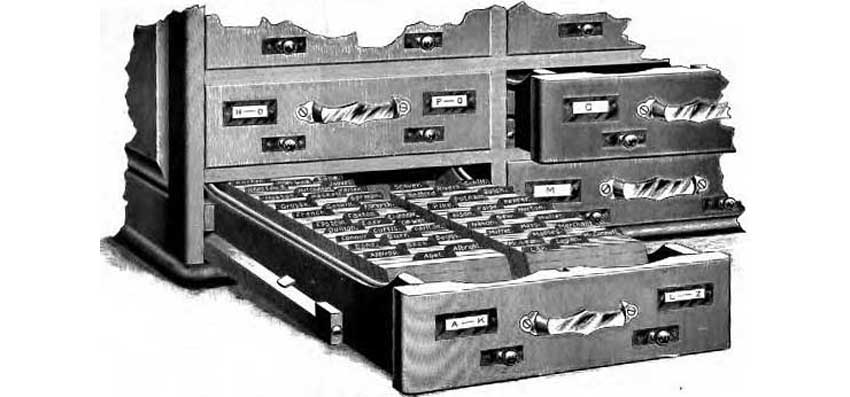


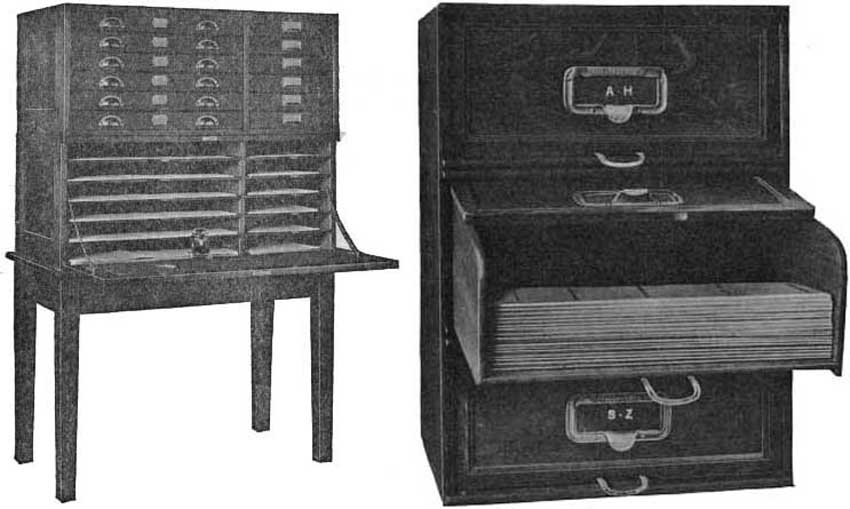
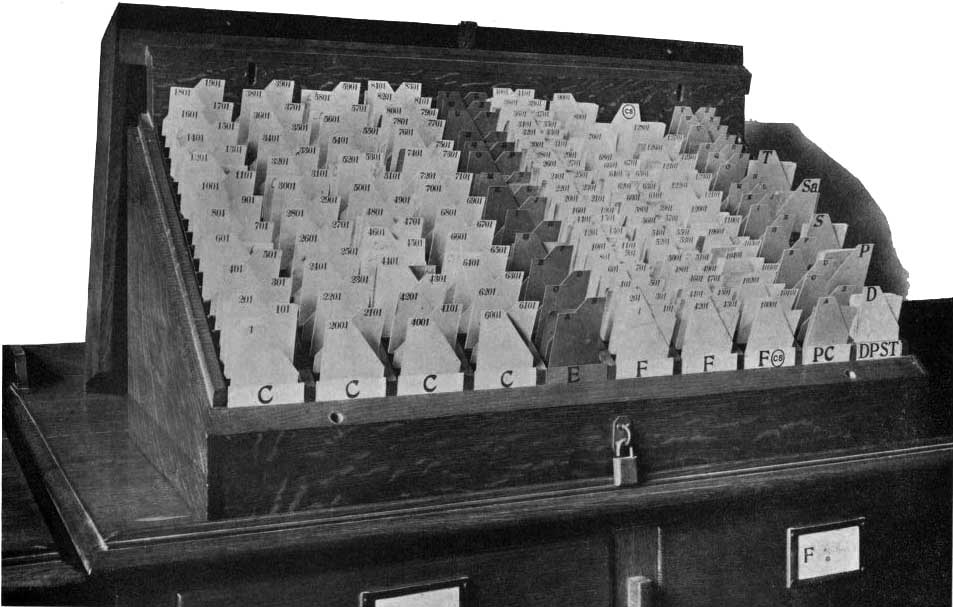

On the security of the data, too, do not forget, by the way. Here's what the password protection database looked like a hundred years ago:

There was a variety of forms, and where there is diversity, there is a classification. The clerks do not feed bread, give something to classify: in our case, card files were classified, depending on the method of attaching the card, the shape of the drawer, the stability of the cabinet, etc. etc.
The first type of card files that I will mention is flat. In fact, folders with clips, in which the cards are attached in the form of loose sheets (as it used to be called in the accounting department).
Filing card "Visiblex" :

Index card "Contefiks" :
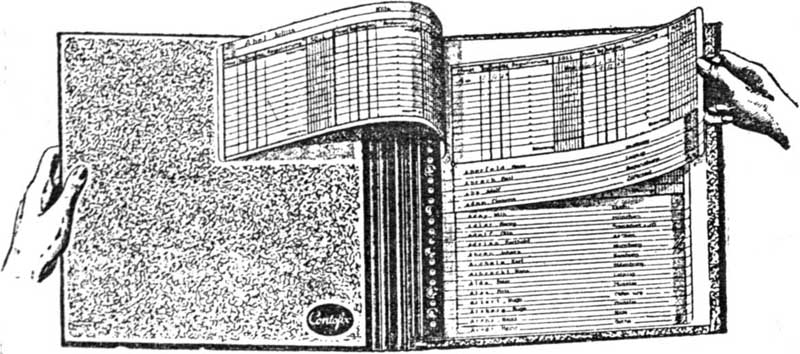
Card file brand "Paul" :
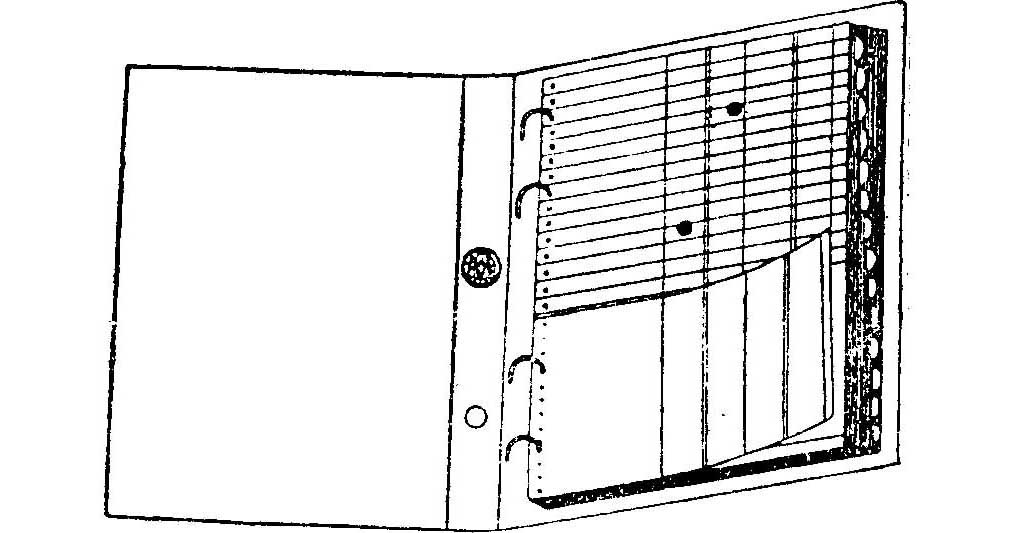
From flat file cabinets proceed to their technological descendants.
The “Sorter” card index: the first version is almost a flat card index, while the second version is a miniature desktop drawer.

But the hanging file "Bartz" . Suspended - because the cards were hung in it at the clips. I'm not sure that this contributed to the work, but the hanging card files were found among other models: “Bartz” was not the only one. Listed below are the suspensions for this kind of file cabinets

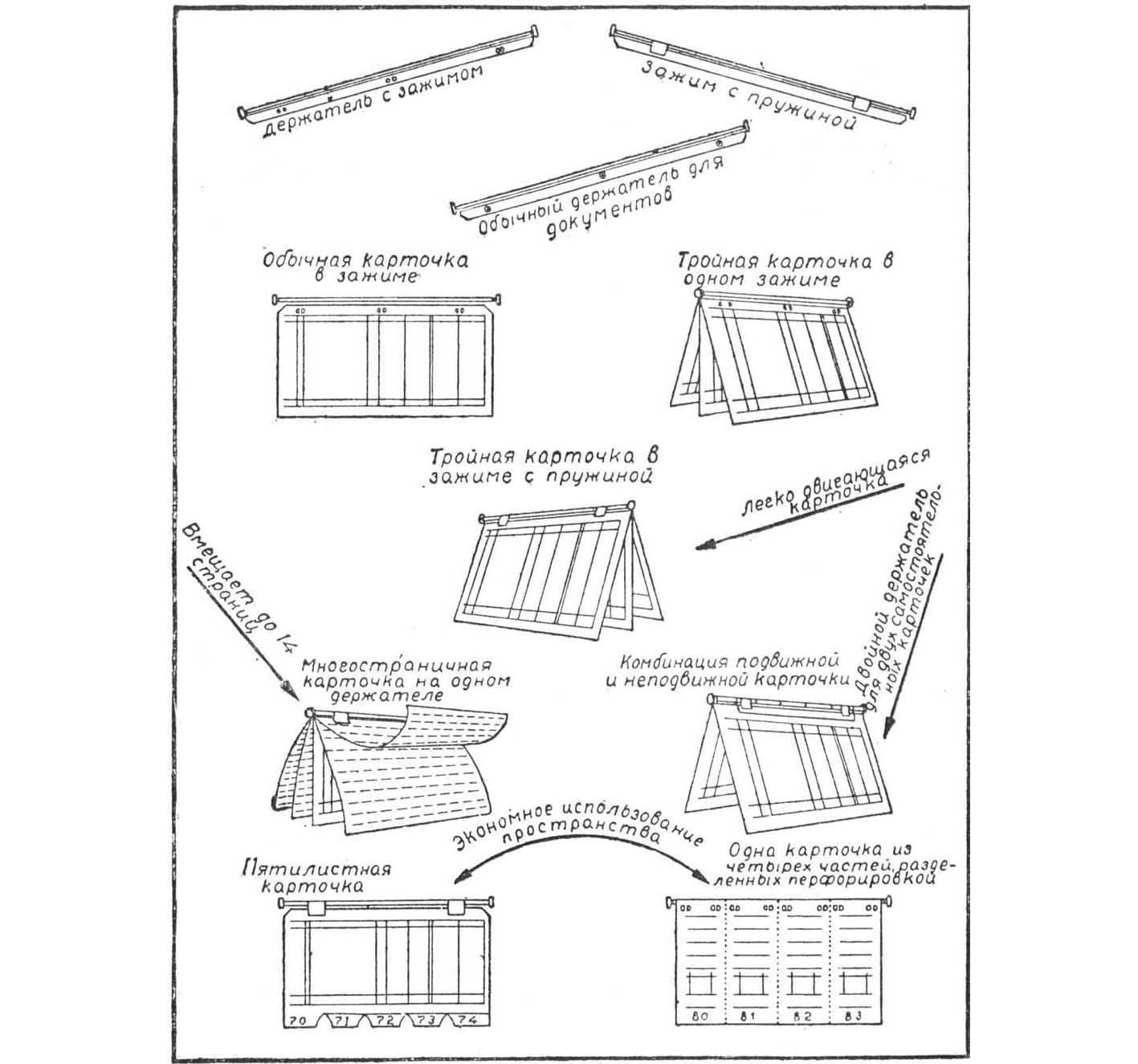
Card index "Cardex" , one of the most popular: references to it are found in the special literature much more often than about the card indexes of other brands. The title of this post is decorated with the image of "Cardex", here are some more pictures:
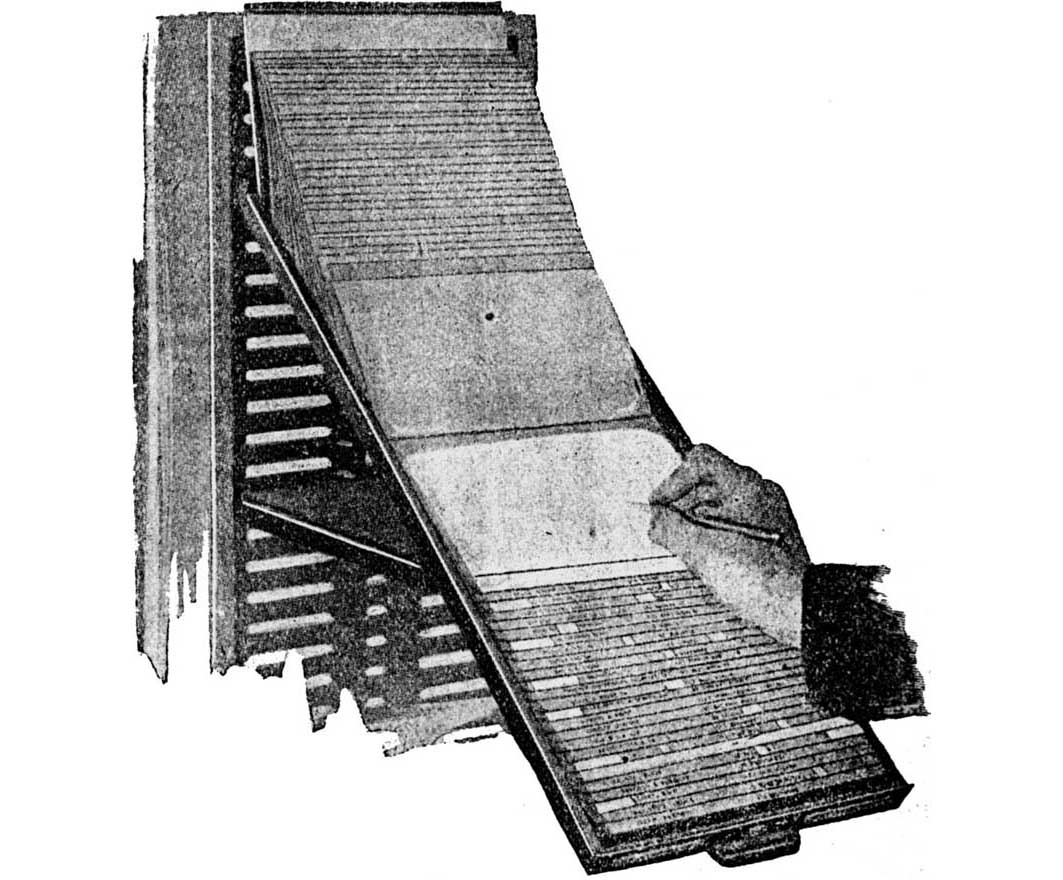


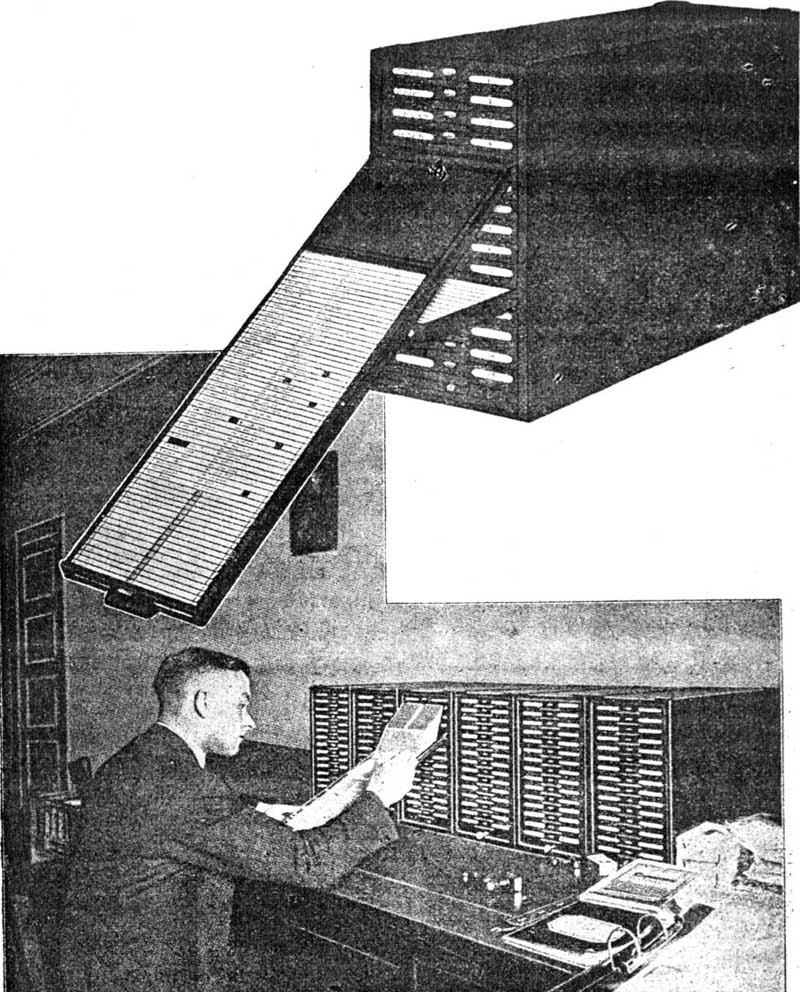
The man in the last photo resembles Tom Hanks as Forrest Gump. I suspect that a frame came to my hands that did not enter the final version of the film. However, it does not matter.
Another card index, brand unknown. Refers to a series of flat - due to the fact that the cards are arranged in boxes one on another: the stack is not "standing", but "lying".
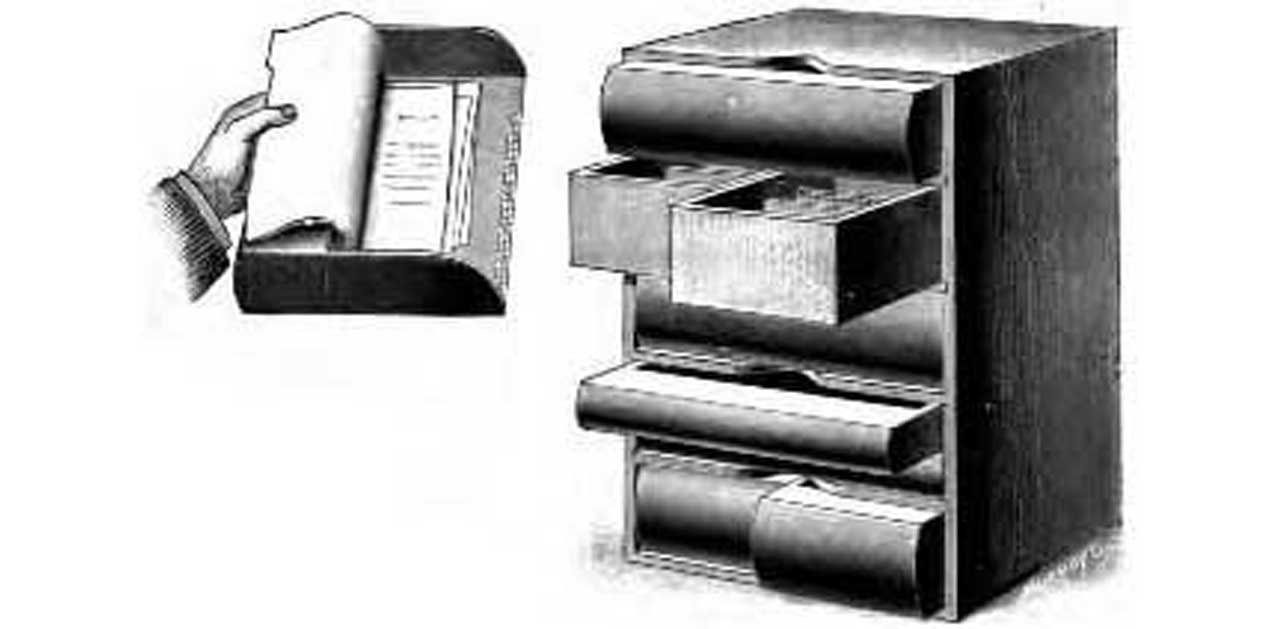
Reached domestic development. In the post about copiers the image of Orgstroy copy board was cited, here is another remarkable achievement of the same designers: Orgstroy card file . Imagine for a few years of hard work for two epoch-making inventions: a copy board and a file cabinet! In this scientific and innovative organization, titans of thought worked, not otherwise.
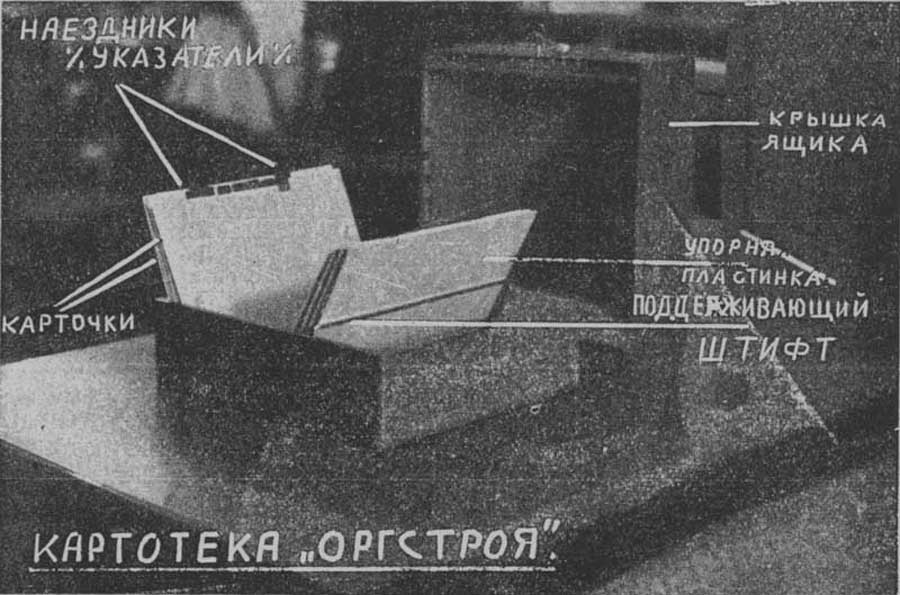
Other domestic developments, but of post-war times: file cabinets on wheels and on bearings. They were called a mobile card file and a rotary card file , if I'm not mistaken.

Also our production, but the 1930s.: Workplace of the card file maker. With the same success it could be called the workplace of the copier (see the post mentioned above on copiers). Card files were often combined with copy boards: everything that was progressive in clerical work was collected in a pile and presented as the latest, as they would be called, innovative achievements.

The so-called line - by - line card file , which differs from the others in that the data were recorded not on wide cards, but on narrow strips of paper. It was possible to cut a line from the ledger and put it into a card file.

Roll file cabinet . Cards were placed in a rotating drum. How could this be preferable to a regular box with a pile of tightly-molded cards, I just can’t imagine. But the fact remains.

Also roll file, but more cumbersome: the mark "Libert" :

Some firms produced card files of all imaginable types: choose - I don't want.
Farp brand files :

Theorists from accounting could not neglect the existence of card files and came up with the term "card bookkeeping": bookkeeping, in which cards are used as information carriers. Card bookkeeping has become one of the so-called forms of bookkeeping.
The scheme of the so-called card-order bookkeeping, in which business transactions are recorded on card-orders:

Cards are used in office work to this day: to make sure of this, it is enough to visit a non-electronic library. Previously, I would not point to such a well-known fact, but now I am not at all sure that any capable person is aware of the existence of non-electronic (paper) libraries. But if it is not practical for you to visit a non-electronic library, take a look at at least the photograph: on the first one there is a card file of an American company, and on the second one is training on working with a card file in a commercial school.
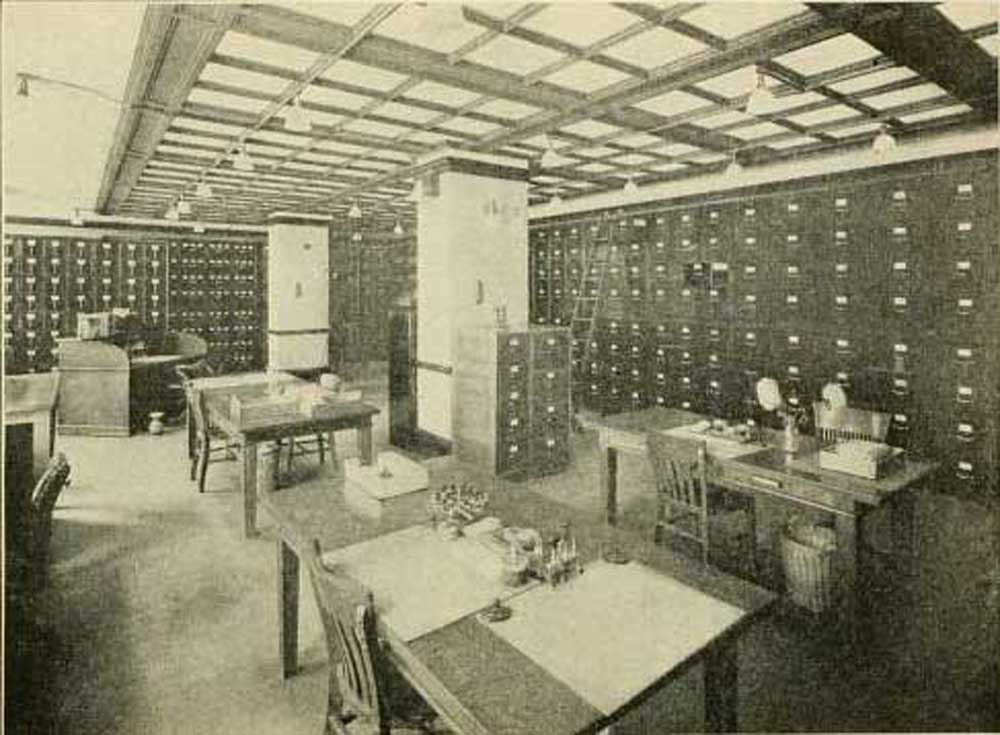
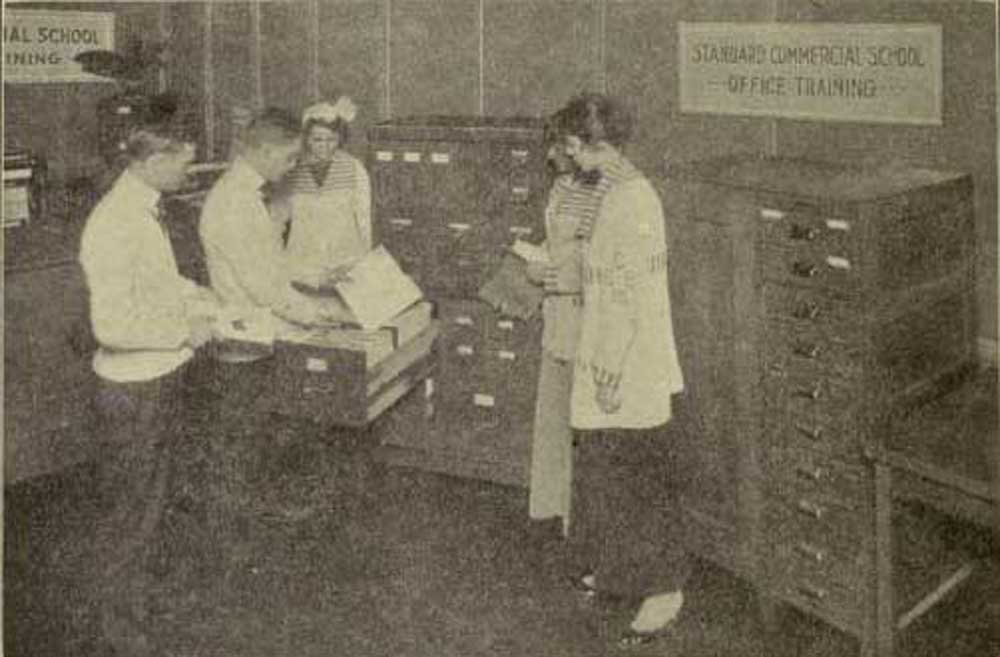
And here are some ads from the American press. The necessary thing was a file cabinet!

Oddly enough, at the same time with card files - even before them! - another direction of data registration emerged and began to develop, and it also used the ubiquitous irreplaceable cards. I mean punching technique.
The principle of perforation itself - punching holes for coding data - was used by J. Jacquard in 1790 in a loom. Subsequently, perforation began to be used in statistics and business for processing large data sets.
The first samples of punching technology came to Russia, apparently, in 1896, when the American engineer Herman Hollerith signed a contract for the supply of his cars for the All-
From the point of view of clerks, punch cards had a number of ineradicable shortcomings, in particular the fact that they had to transfer the information to them from primary documents, to encode. The primary document was taken, the card was filled with it.
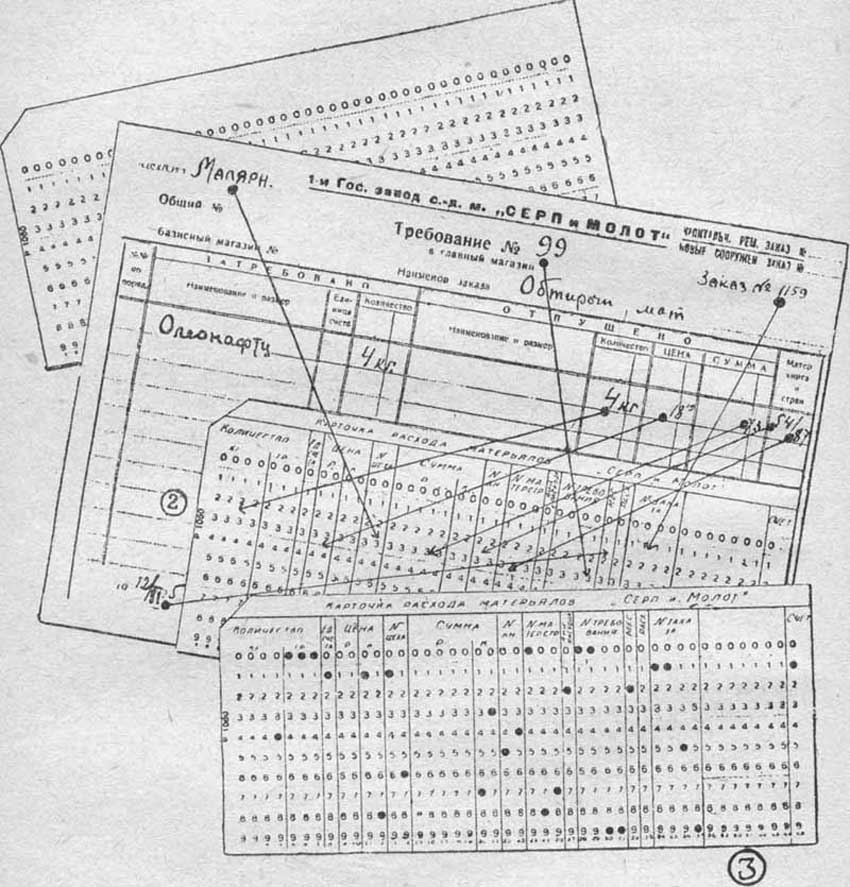
The punch cards themselves could look — and look, depending on the times and device models — in a different way.
Standard Punch Card:

Here are the cards earlier and more intricate, foreign:



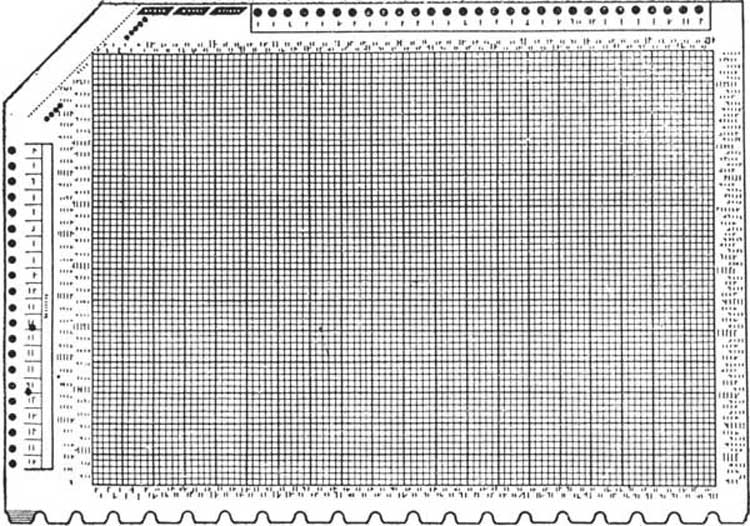
The first two are the Hollerit cards, standard ones, the second two are by an unknown company, with edge perforation . Cards with edge perforation were common.
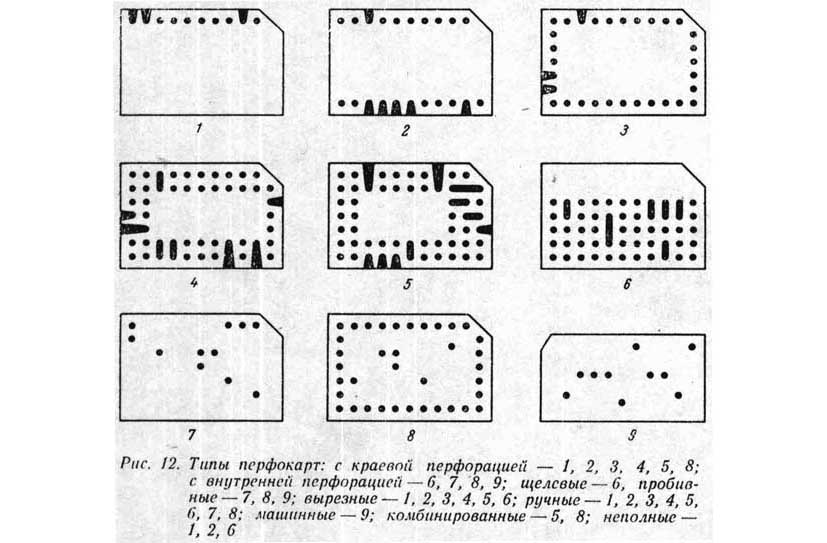
To work with holes instead of numbers is not accounting, oh, not accounting this occupation! Due to numerous requests from working accountants, dual cards were invented, on which coding by means of holes coexisted with ordinary, clear to accountants figures.
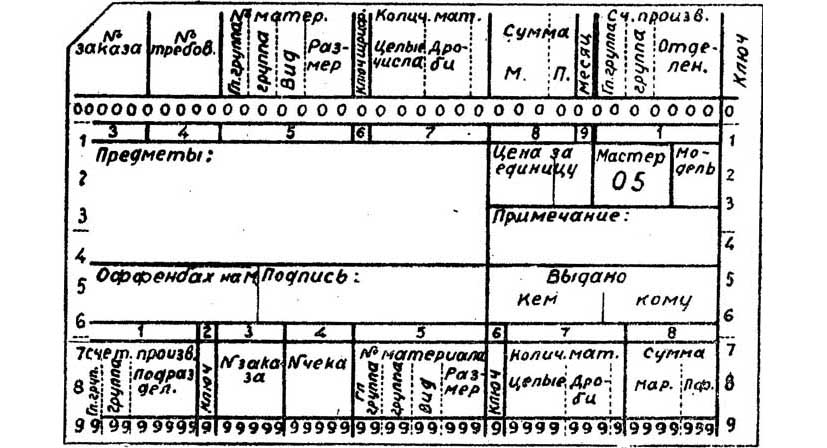
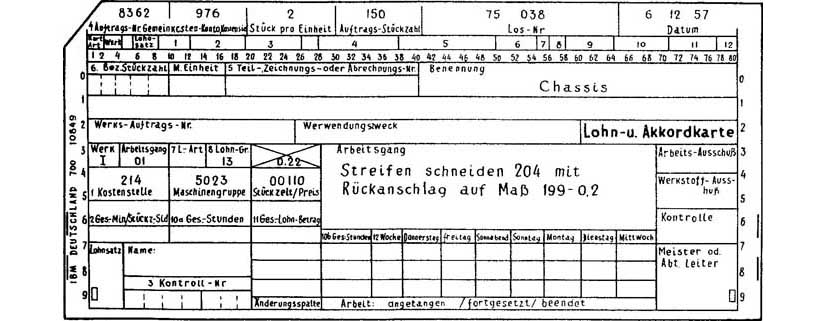
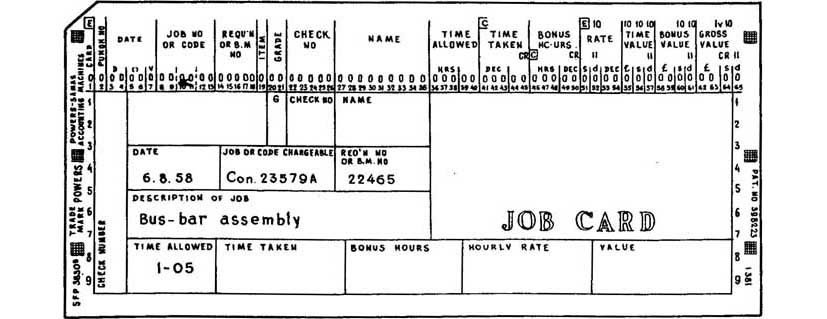

Despite the holes, punch cards compared to ordinary cards had significant advantages, namely, they could be selected, sorted and calculated, for which a special punching technique was used, respectively, sorting machines (sorting) and tabulators . There were also punchers , intended for punching holes, and controllers , allowing to check the punch.
Sort - or rather, choose cards with the desired characteristics - it was possible even manually using a metal rod.
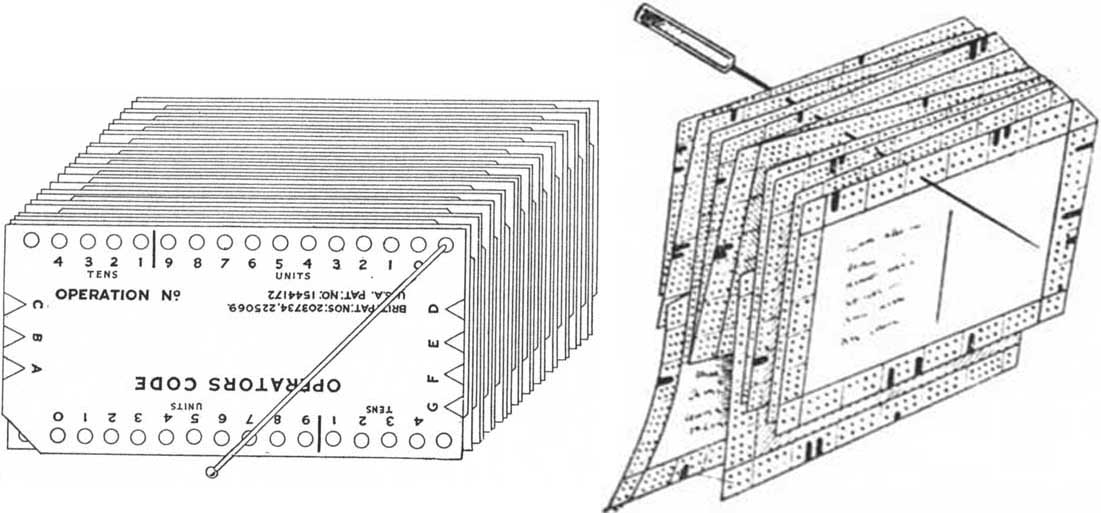
Although there were special devices for sampling. Such devices were called selectors, and there were quite a few models: all of this was a sought-after technique.
The “CIT-Priputeny” selector (CIT is the Central Labor Institute, but I don’t know what propriety is):
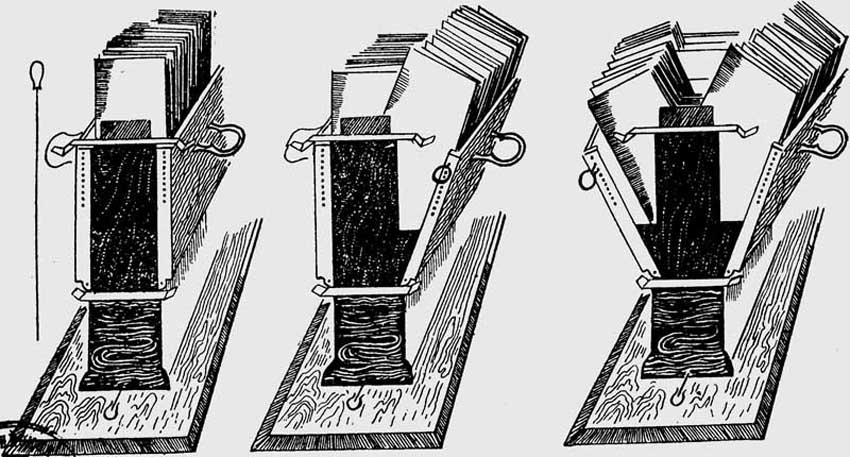
Selectors of other models:
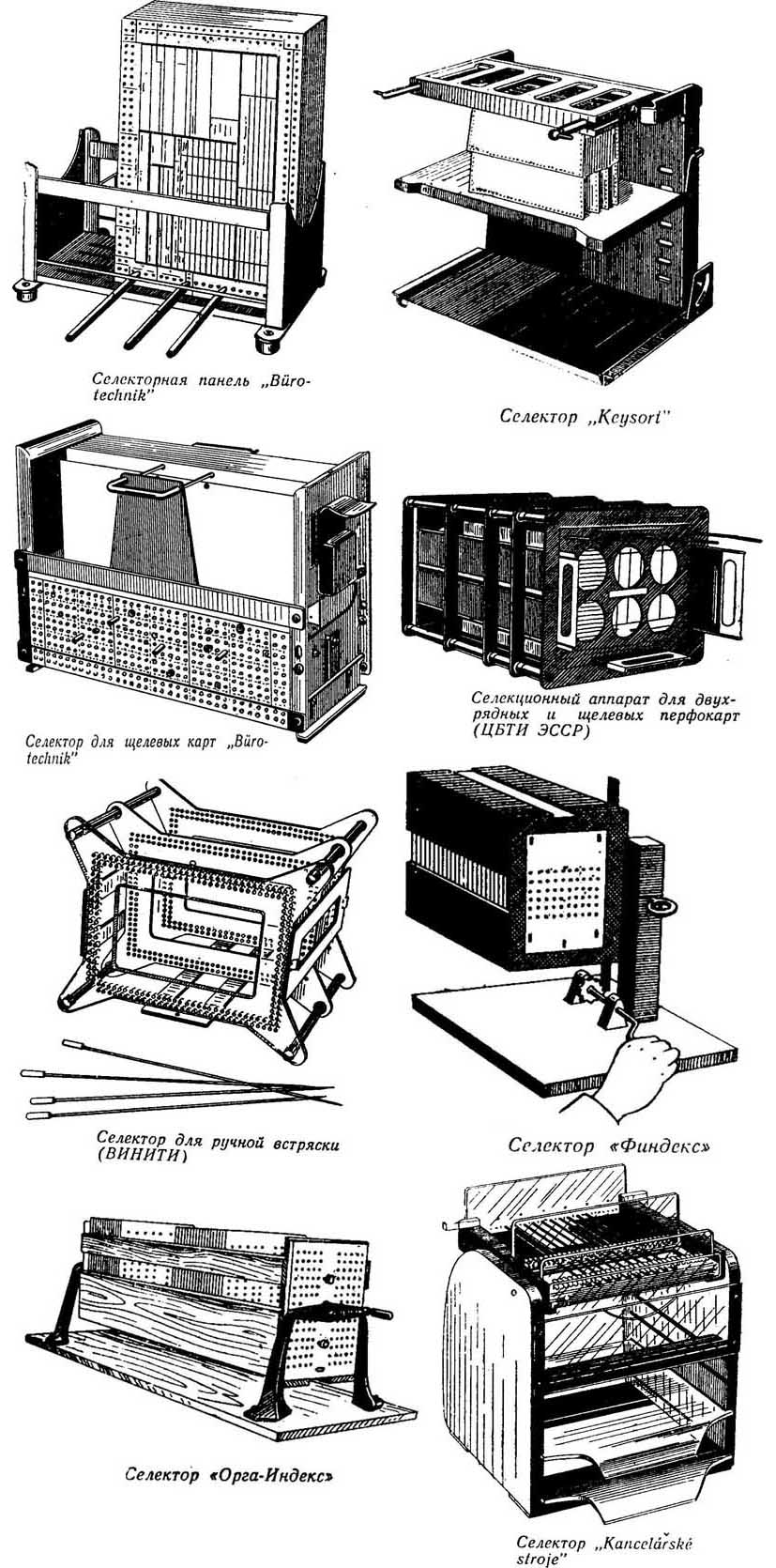
Not at all like devices for working with ordinary card files, is it?
But more powerful devices for sampling and sorting - sorting machines, as it was said:
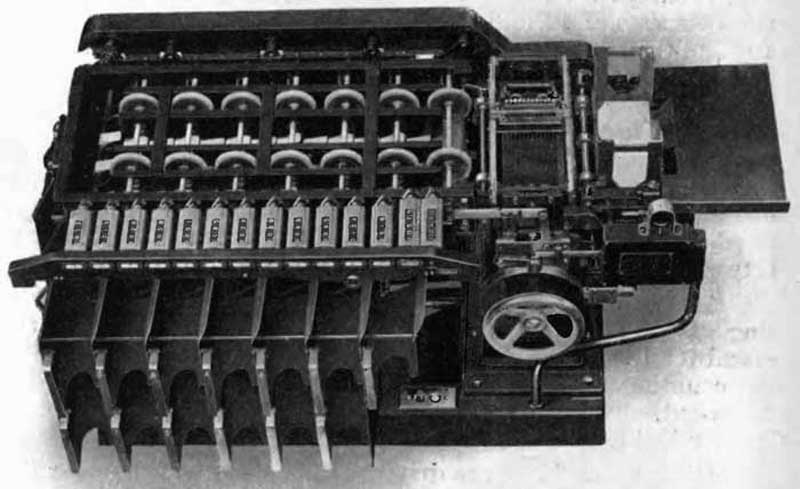

Next - tabs:
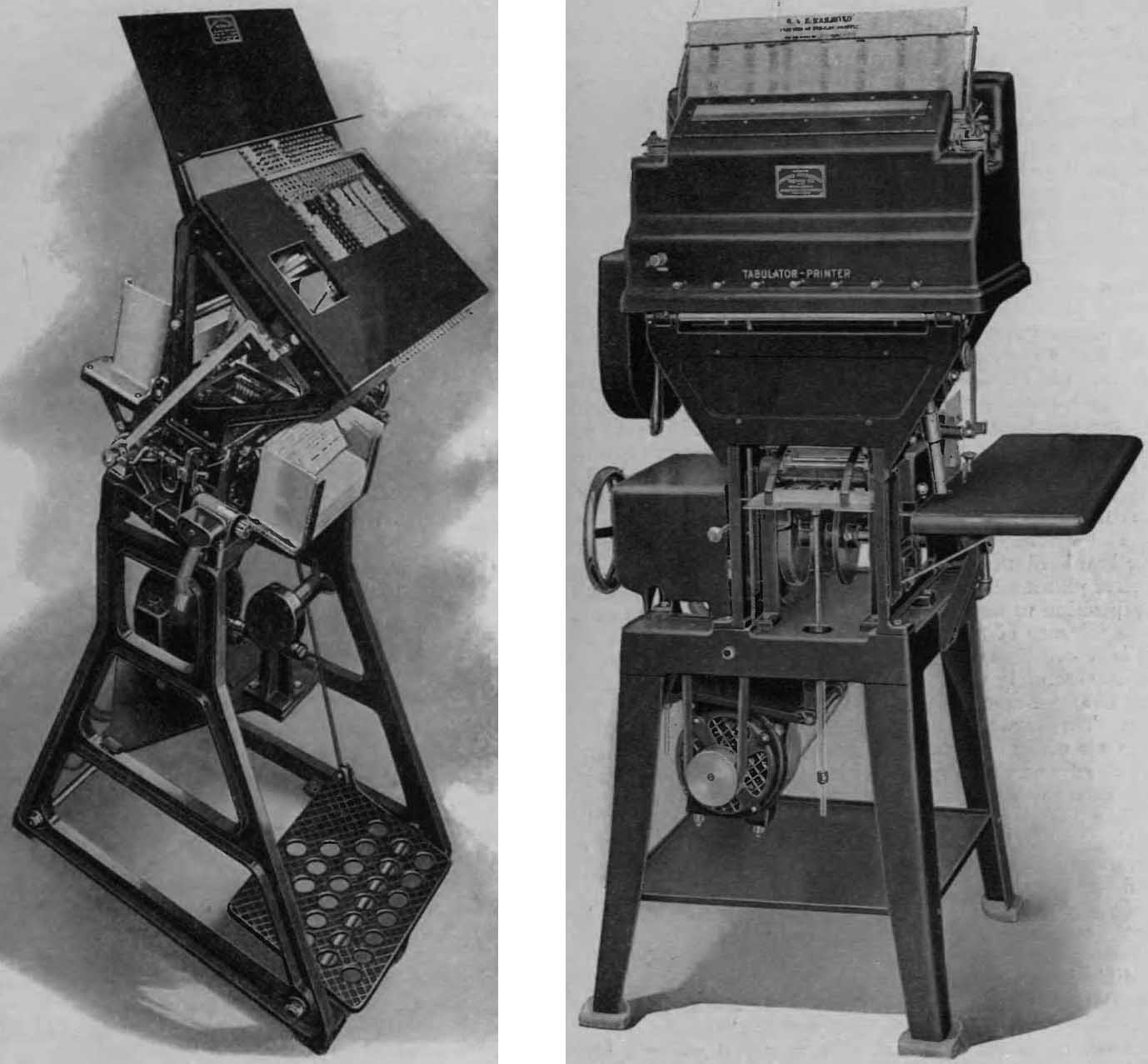

Typists punchers for their working tools: overseas a hundred years ago and our fifty years after that. Punching holes - maybe not quite accounting, but then it pays off with large amounts of processed information.
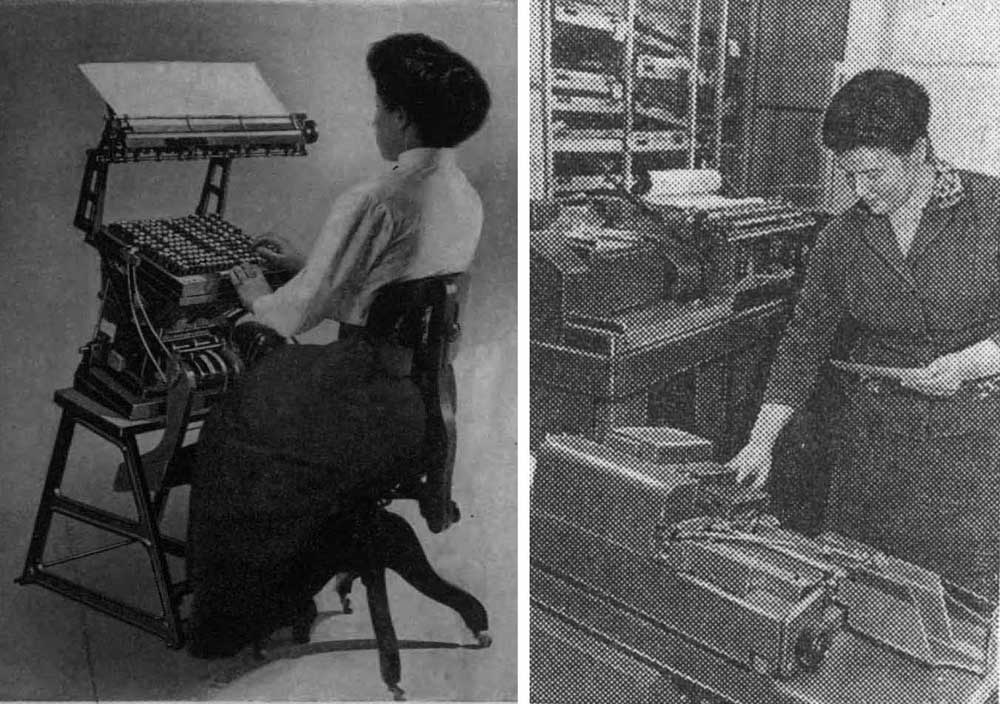
Punching equipment and Soviet factories produced regularly: CAM plant - since 1935. Please, product samples.
CAM Tab :
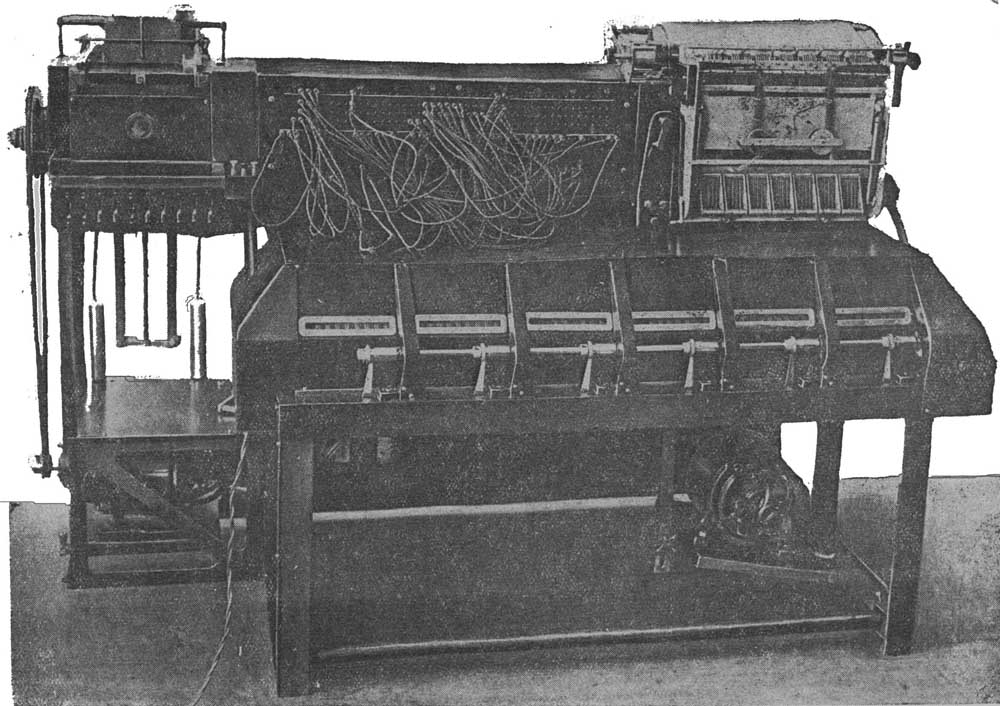
Controller SAM :

CAM sorting machines of different models:
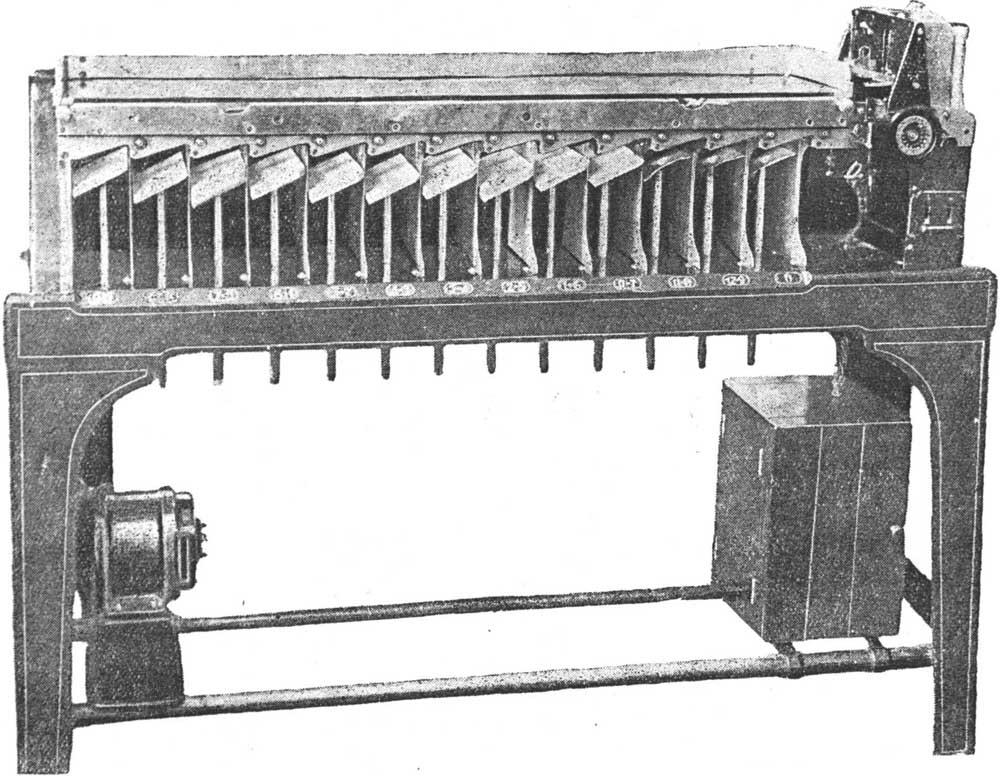

And all this technical wealth is for processing registration cards.
Accountants could not ignore the perforating technique and came up with a new form of accounting - perforating. Under the form of accounting, as you might have guessed, is meant the sequence of information processing depending on the technique used (and if there is no technique, then grouping and sampling data by rewriting from one book or statement to another).
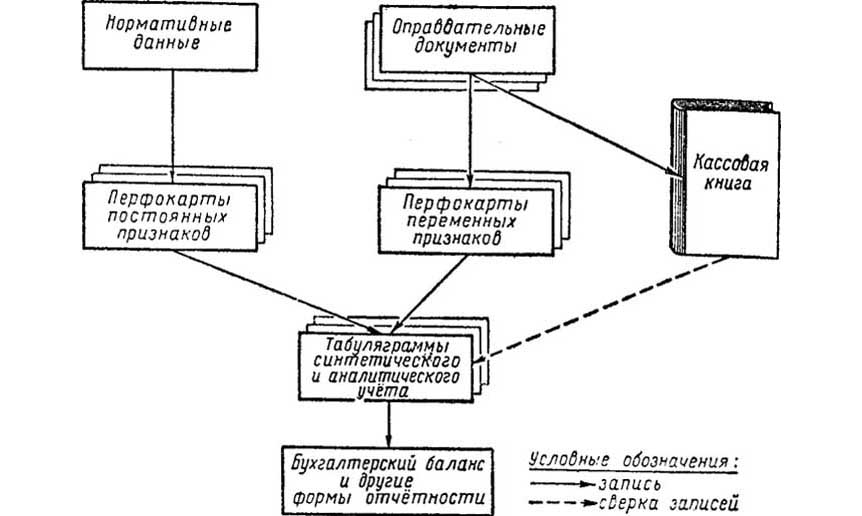
Worked with the punching technique were no longer accountants, but engineers, and data processing rooms were not like quiet accounting and office offices, but machine halls.
Holleritny Department of the German Bank:

Perforation shop at a domestic enterprise:
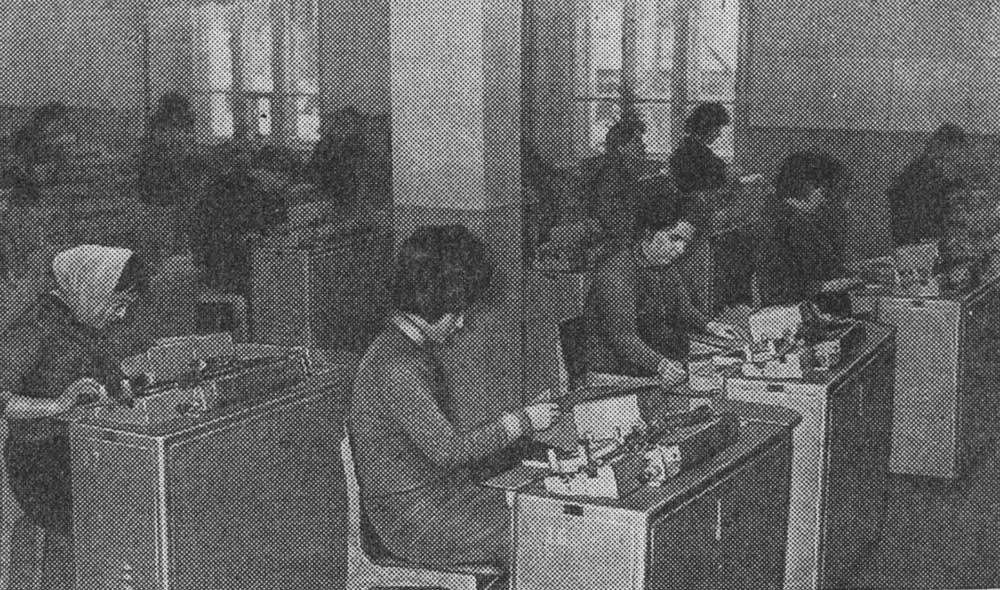
Now everything has changed: the punching technique has gone into oblivion, ordinary card files are still used, but more by inertia. However, do not think that with the victory of the electronic document management card will die, nothing like that! Cards perfectly adapted to the existence of an electronic form, and neither riders nor metal pins are needed for sorting and sampling - you can do without them.
I predict that the cards will remain as long as there are tables, an alternative way to view which they are.
Source: https://habr.com/ru/post/177389/
All Articles